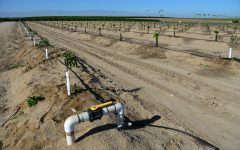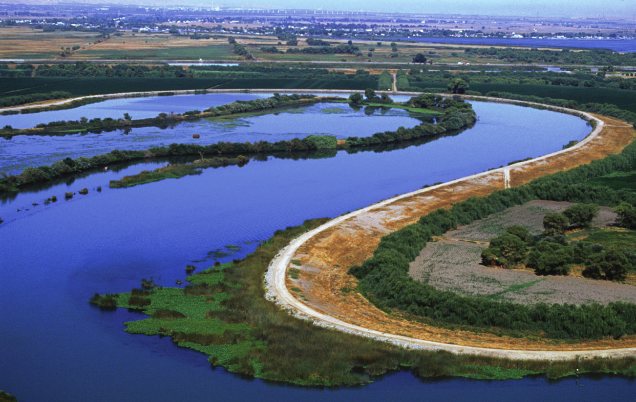
Bay-Delta Plan. (Photo: https://www.waterboards.ca.gov/waterrights/water_issues/programs/bay_delta/)
Ringside: Finding Water for the San Joaquin Valley
Farmers in the San Joaquin Valley now face losing up to 20 percent of their 4.5 million acres of irrigated farmland
By Edward Ring, December 5, 2024 10:43 am
 Farmers in the San Joaquin Valley require roughly 15 million acre feet of water per year to irrigate their crops. In return they produce more than half of all California’s agricultural output. But everything is changing.
Farmers in the San Joaquin Valley require roughly 15 million acre feet of water per year to irrigate their crops. In return they produce more than half of all California’s agricultural output. But everything is changing.
Since 2000 the amount of water the farmers receive from the State Water Project and the Central Valley Project has been cut in order to protect fish, and in response the farmers increased groundwater pumping. This in turn triggered the enactment of the state’s Sustainable Groundwater Management Act (SGMA) in 2014, which limits how much groundwater farmers can use.
Also during the past two decades two major water supply projects, both approved by voters in 2014, have failed to begin construction. The Sites Reservoir, off-stream and just west of the Sacramento River, was to have the capacity to store up to 2 million acre feet (MAF) of water. Subject to interminable delays with a design scaled back to 1.5 MAF of storage, nobody knows if Sites will ever get built. Temperance Flat, a 1.3 MAF reservoir proposed for the San Joaquin River upstream of the existing Friant Dam, was defunded and is effectively canceled.
With less water from the aqueducts, less water from the aquifers, and no new water supply projects, farmers in the San Joaquin Valley now face losing up to 20 percent of their 4.5 million acres of irrigated farmland.
The passage of SGMA was necessary, even if implementation has been challenging. The estimated deficit per year in the San Joaquin Valley between aquifer withdrawals and aquifer recharge was averaging nearly 2 million acre feet per year. But the justification for regulations that lowered water deliveries in order to leave more water in the rivers to help the fish is not beyond debate. Along with maintaining flows, other variables that decisively affect fish survival include habitat restoration, control of alien predators, hatchery expansion and innovation, and upgraded treatment of wastewater discharges. Is that entirety of causes being addressed?
The State Water Resources Control Board (SWRCB) is currently updating the “Water Quality Control Plan for the San Francisco Bay / Sacramento-San Joaquin Delta Watershed.” Hearings for public comment are being held and a final version should be released early in 2025. The impact of the update hinges on which of two options are chosen by the SWRCB; the “voluntary agreements,” or the “unimpaired flows.” The former, painstakingly negotiated with valley water districts, incorporates commitments to working on all variables affecting fish survival, with mandatory flows into and through the delta agreed upon and flexible depending on how successful the overall efforts are in protecting threatened species. The latter, with strong support within some segments of the state water bureaucracies, mandates a percentage of river flow to run unimpaired into the delta regardless of whether or not that is making a positive difference in species survival.
Sources familiar with the Bay-Delta Plan claim that the difference between implementing the “voluntary agreements” option versus implementing the “unimpaired flows” option is about one million acre feet of water per year. They also are careful to clarify that there was nothing “voluntary” about the so-called voluntary agreements, but believe that option will not only result in far more water left available for the valley’s farms and cities, but will also incentivize a more comprehensive strategy to protect threatened species and preserve and restore aquatic habitat.
In general, delta regulations to increase flows for the sake of helping salmon and smelt have not proven effective. Millions of acre feet of water per year are lost because of state mandated cutbacks in water withdrawals from the delta to help these fish, often even during months of high flow. To put this into perspective, the prestigious Public Policy Institute of California estimated that “uncaptured water” flowing through the delta and out to the Pacific Ocean “averaged 11.3 MAF [per year] over the 1980-2016 period.” Since then, California has had above average rainfall in 2017, 2019, 2020, 2022, and 2023, which tends to repudiate any suggestion that the state is getting dryer. In the winter of 2023, over 27 million acre-feet flowed through the Delta and out to the Pacific.
So how will farmers in the San Joaquin Valley get more water? An option with great potential is to expand recharge basins to absorb floodwater. From storm runoff in January to snowmelt in June, diverting water when rivers are running high is a cost effective way to recharge aquifers. Because water diffuses into aquifers more broadly the deeper it percolates, a long narrow recharge basin can absorb water more quickly than a circular pond. Basins that leave the area to be flooded undisturbed during construction cost less, because you don’t have to use heavy equipment to grade the bottom, then send additional heavy equipment back in to decompact the bottom. They also are more immediately hospitable as wildlife habitat.
In ideal conditions, water percolates surprisingly fast, up to a foot every four days. Some basins can percolate water much faster, up to a foot per day. And those vaunted “paleochannels” can potentially soak up water as fast as it can be delivered. The total runoff into the San Joaquin Valley that isn’t already harvested for recharge but could be is estimated to average somewhere between 700,000 and 900,000 acre feet per year. This means that even at the rate of a foot of percolation every four days, if you allocated 90,000 acres for new floodplains and could keep them filled and percolating for 40 days, you would bank 900,000 acre feet of water each year that might otherwise go unused. If you can keep them filled for 120 days, which might be possible in some years, you would only need 30,000 acres of basins.
The ultimate solution is to develop the capacity to take the “big gulp.” Even if the state and federal pumps ran unimpeded during the biggest winter storms, they can only withdraw about 28,000 acre feet per day. During major storms, well over 100,000 acre feet per day can run through the delta uncaptured. Enter, once again, the concept of Fish Friendly Delta Diversions. Build a levee on the inside and parallel to an existing Delta Island levee, cut a weir in both ends, line the channel and fill it with rocks and gravel that cover perforated pipes. Relying only on gravity, withdraw delta water from the channel without harming fish or altering the current. Engineering studies estimate a 200 acre site could withdraw 15,000 acre feet per day. The cost? About $3 billion, which is a bargain.
The fate of the San Joaquin Valley’s farmers is uncertain. They await the final version of the Bay Delta Plan. They wonder what the Trump administration is going to attempt on their behalf, as well as the consequences they might face from a vindictive Newsom administration if they attempt to work with Trump’s appointees. They anticipate more water from the Sites Reservoir, but know that’s going to take additional decades, if ever, to have an impact. And they know that in a saner state, Temperance Flat would already be built, instead of all but forgotten. The biggest agribusiness concerns adapt, the small farmers that produce diverse crops fight to stay alive. The recently approved water bond promises money to fund recharge projects, a godsend for farmers confronting unprecedented increases in the cost for fuel, seed and fertilizer at the same time as prices are depressed for most agricultural commodities.
There are ways to deliver ample water to San Joaquin Valley farmers, while also protecting the environment. Together, the voluntary agreements, the Sites Reservoir, aquifer recharge projects, and the Fish Friendly Delta Diversions project have the potential to do it all. Making that happen will require unity of purpose from the water agencies and farmers, and a realization among Sacramento elected officials that new approaches may help the environment more than the failed approaches to-date.
- Ringside: Will Advocates for More Water Supply Projects Find Unity? - December 11, 2025
- Ringside: EVs and California’s Future Demand for Electricity - December 4, 2025
- Ringside: Politically Viable Water Supply Projects - November 27, 2025




Great job. See also my https://www.theepochtimes.com/opinion/californias-perpetual-drought-is-manmade-and-intentional-5640514
Trump and Devin Nunes plan to help California water probably through federal pipes and dams of the Bureau of Reclamation.
Nah, CA agriculural industry is a main driver behind perpetual droughts in the state. 40 million humans gotta flush.
Better approach would be to idle farmlands. Let China grow food for us and we buy their solar/wind products to cover the aformentioned idled farmland and then we gets the good ‘lectricity thas clean and cheap…..
How about sending Newsom and the rest of the communist Democrats to China instead.
I think it’s pretty simple. Quit draining the reservoirs, build more reservoirs, scrap the plans to demolish existing reservoirs and permit and build the desalinization plants designed and ready for construction near large population centers. I think the water squeeze on farmers and the general population is being done on purpose because no one can be so stupid. Witness the famines Lenin, Stalin and Mao unleashed on their populations, and there’s no doubt in my mind that the ruling class in Sacramento are a like bunch of communists.